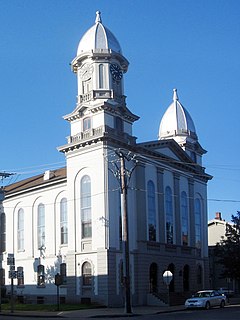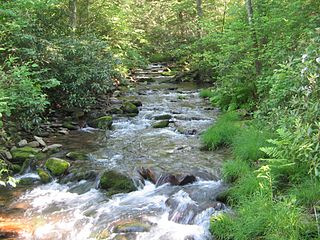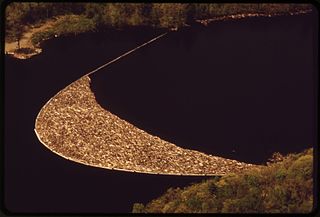
Lock Haven is the county seat of Clinton County, in the U.S. state of Pennsylvania. Located near the confluence of the West Branch Susquehanna River and Bald Eagle Creek, it is the principal city of the Lock Haven Micropolitan Statistical Area, itself part of the Williamsport–Lock Haven combined statistical area. At the 2010 census, Lock Haven's population was 9,772.

Cogan House Township is a township in Lycoming County, Pennsylvania, United States. The population was 955 at the 2010 census. It is part of the Williamsport, Pennsylvania Metropolitan Statistical Area.

Cummings Township is a township in Lycoming County, Pennsylvania, United States. The population was 273 at the 2010 census, down from 355 at the 2000 census. It is part of the Williamsport, Pennsylvania Metropolitan Statistical Area. Cummings Township is home to Little Pine State Park and Upper Pine Bottom State Park.

Duboistown is a borough in Lycoming County, Pennsylvania, United States. The population was 1,205 at the 2010 census. It is part of the Williamsport, Pennsylvania Metropolitan Statistical Area.

Mifflin Township is a township in Lycoming County, Pennsylvania, United States. The population was 1,070 at the 2010 census. It is part of the Williamsport Metropolitan Statistical Area.

Plunketts Creek Township is a township in Lycoming County, Pennsylvania, United States. It includes the villages of Barbours and Proctor. The population was 684 at the 2010 census,, down from 771 at the 2000 census. It is part of the Williamsport Metropolitan Statistical Area.

South Williamsport is a borough in Lycoming County, Pennsylvania, United States. It is famous for hosting the Little League World Series. The population was 6,379 at the 2010 census. It is part of the Williamsport, Pennsylvania Metropolitan Statistical Area.

Susquehanna Township is a township in Lycoming County, Pennsylvania, United States. The population was 1,000 at the 2010 census. It is part of the Williamsport Metropolitan Statistical Area.

Washington Township is a township in Lycoming County, Pennsylvania, United States. The population was 1,613 at the 2000 census. It is part of the Williamsport, Pennsylvania Metropolitan Statistical Area.

The West Branch Susquehanna River is one of the two principal branches, along with the North Branch, of the Susquehanna River in the northeastern United States. The North Branch, which rises in upstate New York, is generally regarded as the extension of the main branch, with the shorter West Branch being its principal tributary. The West Branch, which is 243 miles (391 km) long, is entirely within the state of Pennsylvania, draining a large mountainous area within the Allegheny Plateau in the western part of the state. Along most of its course it meanders past mountain ridges and through water gaps, forming a large zigzag arc through central Pennsylvania around the north end of the Allegheny Mountains. In colonial times the river provided an important water route to the Ohio River valley. In the 18th century, its lower valley became a significant industrial heartland of Pennsylvania. In the 20th century, the upper reaches of the West Branch turned a yellow/orange color due to sulfurous drainage from nearby and abandoned deep bituminous coal mines.

White Deer Hole Creek is a 20.5-mile (33.0 km) tributary of the West Branch Susquehanna River in Clinton, Lycoming and Union counties in the U.S. state of Pennsylvania. A part of the Chesapeake Bay drainage basin, the White Deer Hole Creek watershed drains parts of ten townships. The creek flows east in a valley of the Ridge-and-valley Appalachians, through sandstone, limestone, and shale from the Ordovician, Silurian, and Devonian periods.

A log boom is a barrier placed in a river, designed to collect and or contain floating logs timbered from nearby forests sometimes called a fence or bag. The term is also used as a place where logs were collected into booms, as at the mouth of a river. With several firms driving on the same stream, it was necessary to direct the logs to their owner's respective booms, with each log identified by its own patented timber mark. One of the most well known logbooms was in Williamsport, Pennsylvania, along the Susquehanna River. The development and completion of that specific log boom in 1851 made Williamsport the "Lumber Capital of the World".

Susquehanna State Park is a Pennsylvania state park on 20 acres (8.1 ha) in Williamsport in Lycoming County, Pennsylvania in the United States. The park is on the West Branch Susquehanna River in the western part of Williamsport, and is operated by the Williamsport / Lycoming Chamber of Commerce in cooperation with the Bureau of State Parks of the Pennsylvania Department of Conservation and Natural Resources. Susquehanna State Park offers cruises on a paddlewheeler, boating, fishing, and picnicking.

The West Branch Susquehanna Valley of central Pennsylvania, United States, in the Ridge-and-valley Appalachians, is the low-lying area draining into the West Branch Susquehanna River southeast of the Allegheny Front, northeast of the Bald Eagle Valley, southwest of the Wyoming Valley and north of the water gap formed between Shamokin Mountain and Montour Ridge.

This article details a history of Lycoming County, Pennsylvania.

Peter Herdic (1824–1888) was a lumber baron, entrepreneur, inventor, politician, and philanthropist in Victorian era Williamsport, Lycoming County, Pennsylvania in the United States. He was the youngest of seven children born to Henry and Elizabeth Herdic on December 14, 1824 in Fort Plain, New York. Herdic's father died in 1826 and Elizabeth Herdic remarried shortly thereafter. She was widowed again prior to 1837 when she moved her family to Pipe Creek, New York near Ithaca. Herdic attended school for just a few years while he worked on his mother's 50-acre (200,000 m2) farm. Herdic left his mother's farm in 1846 and arrived in Lycoming County later that same year, where he settled in Cogan House Township.

The Pennsylvania Lumber Museum is near Galeton, Potter County, Pennsylvania in the United States. It documents the history and technology of the lumber industry that was a vital part of the economic development and ecological destruction of Pennsylvania.
Williamsport was incorporated as a borough on March 1, 1806, and as a city on January 15, 1866. The city is the original home of Little League Baseball, founded in 1939 as a three-team league.

Plunketts Creek is an approximately 6.2-mile-long (10 km) tributary of Loyalsock Creek in Lycoming and Sullivan counties in the U.S. state of Pennsylvania. Two unincorporated villages and a hamlet are on the creek, and its watershed drains 23.6 square miles (61 km2) in parts of five townships. The creek is a part of the Chesapeake Bay drainage basin via Loyalsock Creek and the West Branch Susquehanna and Susquehanna Rivers.

Pine Creek Gorge, sometimes called The Grand Canyon of Pennsylvania, is a 47-mile (76 km) gorge carved into the Allegheny Plateau by Pine Creek in north-central Pennsylvania.





















